Art & Exhibitions
Biennale of Sydney Keeps Turnstiles Moving
Carnival atmosphere masks increasingly passive spectatorship of art.
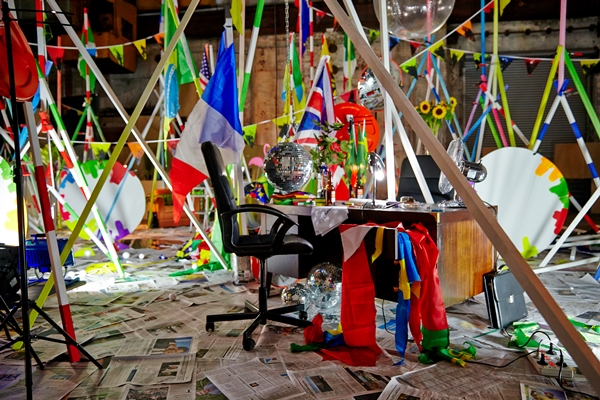
Carnival atmosphere masks increasingly passive spectatorship of art.

Adam Geczy

Since their rise as a global phenomenon in the 1980s, Biennales have undergone a striking evolution. They were first touted as offering the local public a snapshot of what was happening all around the world. This proved far too arduous a task and curators turned to vague philosophical propositions, hopefully relevant to the present moment, by which the chosen artists could be positioned. This also proved too hard, because one size doesn’t fit all. Now Biennales are neither of these, so that art can just be art: The curatorial dogma has lapsed into an incontestably everything-and-nothing abstraction. And now that Biennales have abandoned their ambitions to make any great claims, art can be served up as its own special kind of entertainment, basking in the afterglow of corporate sponsorship, whose sole request is that visitors keep the turnstiles moving.
The 19th Biennale of Sydney, and the rhetoric of the artistic director Juliana Engberg, was so thick with positivity that it begged a good deal of questions about the collusion of art and entertainment that has been rife since Pop art in the 1960s. As any clinical psychologist is apt to tell you, one of the causes of suicide in all ages is that of the expectation that one is happy. Today’s obsession with happiness occurs at precisely the time when there are numerically more unhappy people than ever lived in the history of mankind, and where this unhappiness is jealously maintained. Curiously enough, the title for this Biennale, ‘Imagine What You Desire’, is a phrase that conjures its cynical counterpart, ‘be careful what you wish for’, a corrective that pits desire against its factual consequences. Contemporary society has not only imagined but realized a great deal of desire (not to mention the hyperbolic proportion of pornography on the Internet), which has had disastrous consequences. This is not to argue that curators should be presenting a vale of death, and a Biennale about the depressing state of the world may be a little too heavy-handed. Yet a Biennale that was less sure of itself and more interrogative of what contemporary art means, and the values we choose to evaluate it, a Biennale about uncertainty and instability in short, would have been more stimulating and, philosophically, more exciting.
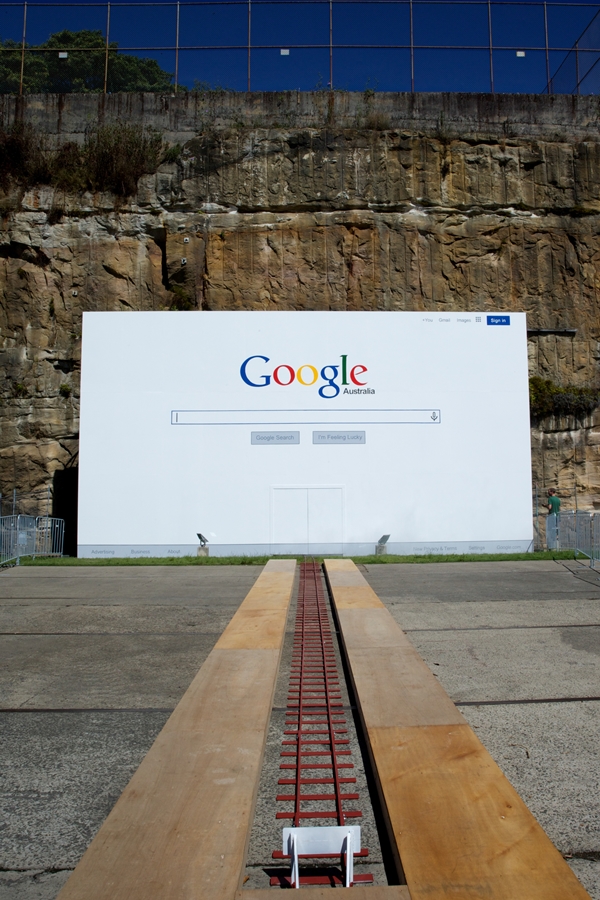
Callum Morton, The Other Side (2014). Installation view of the 19th Biennale of Sydney at Cockatoo Island.
Courtesy the artist and Roslyn Oxley9 Gallery, Sydney Created for the 19th Biennale of Sydney. Photo: Ben Symons.
Cockatoo Island, the site most popular for family weekend daytrips, seemed particularly geared to entertainment. Callum Morton’s The Other Side made explicit references to sideshows and carnival entertainment, in which the audience were expected to sit in little buggies like those for a circus ride. Simulating a chamber of horrors, what was most remarkable about the work is how often it broke down. Morton is otherwise a highly astute artist, but this was not him at his best. The periodic dysfunctionality of his work was complemented by the work of Swiss artists Gerda Steiner and Jörg Lenzlinger. Their Bush Power (2014) was a fantastical environment of motley paraphernalia centred around nautilus gym equipment, that viewers were invited to use, their movements powering and altering connected objects nearby. An unaccountable encounter between a gymnasium and a crèche, again, many of the machines broke, and those who persisted with the interactive component were repeatedly advised by the invigilating volunteers to go easy, unwittingly playing the obverse of the personal trainer (‘do less!).
The carnival atmosphere on Cockatoo Island was maintained with Danish artist duo Randi and Katrine’s The Village, a stylized, motley fairytale European village. The website blurb bore the uncanny resemblance to an advertisement for mini-golf: ‘a scaled-down Danish village for viewers of all ages to explore’. Meanwhile the work of Susan Norrie, a video of Japanese protest against the use of nuclear energy, was assurance that works of political naïvete have not lost their appeal. While the point is open to debate, that is the context of so-called global art, it is today inadequate for the artist-tourist with only anecdotal investment in the issues of another nation to masquerade political voyeurism as politically committed art. The artistic director must also bear responsibility for this. For an artist to peregrinate onto one socio-political problem after another, pointing to crisis, is a form of veiled mendacity that helps to sustain the status quo, since, in aestheticizing what is effectively news (which itself is already aestheticized) it emphasises passive spectatorship over agency.
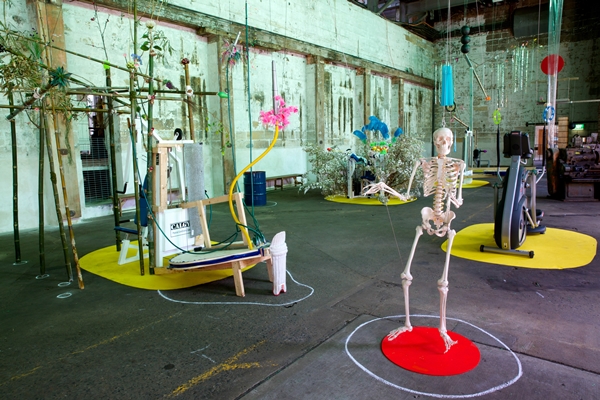
Gerda Steiner & Jörg Lenzlinger, Bush Power (2014). Installation view of the 19th Biennale of Sydney at Cockatoo Island. Courtesy the artists. Photo: Ben Symons.
A similar political disingenuousness permeated the work of Hubert Czerepok (Let’s Change it All, 2014), a series of performance events in which the artist assembled children and had them write banners relating to what they wish for, or what they want changed. In turn, the children’s exhortations ranged from the frivolous (more Lego, more sport etc.) to the precocious (about world events). They then paraded their slogans in public places. This work effectively reduced to caricature what has been one of the most important means of popular dissent—especially in the artist’s home country, Poland, whose public movements contributed in no small part to Perestroika—in the Republican age. It cutsefied and, by extension ridiculed, a form of protest whose effectiveness is now uncertain (as with the Occupy Wall Street movement), yet still a last resort of subjugated groups as witnessed in the last few years in the upheavals of the Middle East. To make light of public protest like this is of a piece with the way in which commercial news agencies package world events into anodyne, digestible units, dimming our personal affect, rendering the viewer dissociative and apathetic.
Two works were a critical foil to this example of ersatz political concern. The first was the digitally generated video installation by the Danish artist Eva Koch of a large waterfall. Using the capacious spaces of the halls of Cockatoo Island to stunning effect, viewers saw the projection at the end of the room, while the thunderous crashing sounds filled the space. Koch’s work also suggests that the ecology movement is itself a demarcated, quarantined subset of what is a much greater problem, namely the effects of overpopulation. But it is because of the need for space and the environmental devastation that will ensure that will also require us to call on virtual replicas of what once was. Koch’s work reminds us to what extent we have been reduced to passive spectatorship, and that there are powers well beyond our knowledge or control.
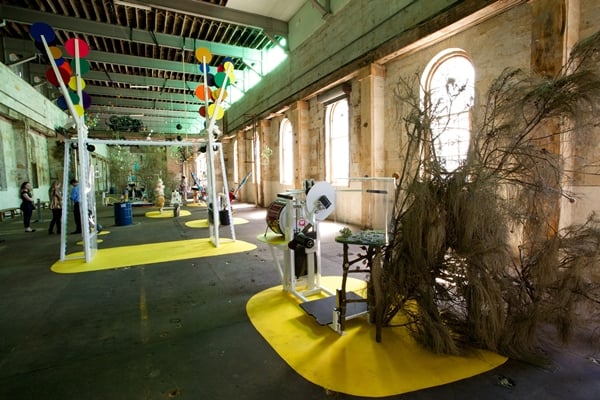
Gerda Steiner & Jörg Lenzlinger, Bush Power (2014). Installation view of the 19th Biennale of Sydney at Cockatoo Island. Courtesy the artists. Photo: Ben Symons.
The other work was by Bianca Hester. With the intriguing title, Fashioning Discontinuities(2013-14), Hester embarked on a series of interventions both on Cockatoo Island and within the city of Sydney itself. Fluid and open-ended, Hester’s work stems from Fluxus and the work of Gordon Matta-Clark who explored the possibility of intervening on social spaces to induce a momentary break from habitual ways of seeing the world, much in the manner of the Situationist détournement. Hester’s projects have traditionally sought to reach points of extremity, while constantly inquiring as to the difference between an action pure and simple and an action in the realm of art. Hence the objects in her works are merely points of juncture between different modalities of viewing, creation and intervention.
In the middle of a still rather empty-feeling main chamber of the venue Carriageworks was stationed Dutch artist Gabriel Lester’s large visual one-liner of a colonial style wooden house from whose every window were billowing curtains, but frozen in motion. Although haunting, it seemed to rely too heavily on its own cleverness. By contrast, in its sophistication and wit, the work of Austrian artist Mathias Poledna was welcome respite. Walking in on Village by the Sea (2011), one could have mistaken the film for an excerpt from a 1940’s black and white musical in which a man and a woman sing to one another is a nicely appointed Manhattan apartment. However the sequence is not feature length, only about five minutes. This was a beautifully resolved work that was unencumbered with the superficial political urgencies of other works, which allowed it all the more to stage issues of gender relations, nostalgia and the stylised, packaged nature of culture. Complementary to this work was the video installed nearby by Persijn Broersen and Margit Lukács, Mastering Bambi, consisting of scenes from the 1942 Disney animation about the sweet talking deer faun but with said deer faun removed, leaving a landscape more sinister than saccharine. It was as if the artists had removed the popularist agendas of mass entertainment to reveal the sinister ideological underbelly.
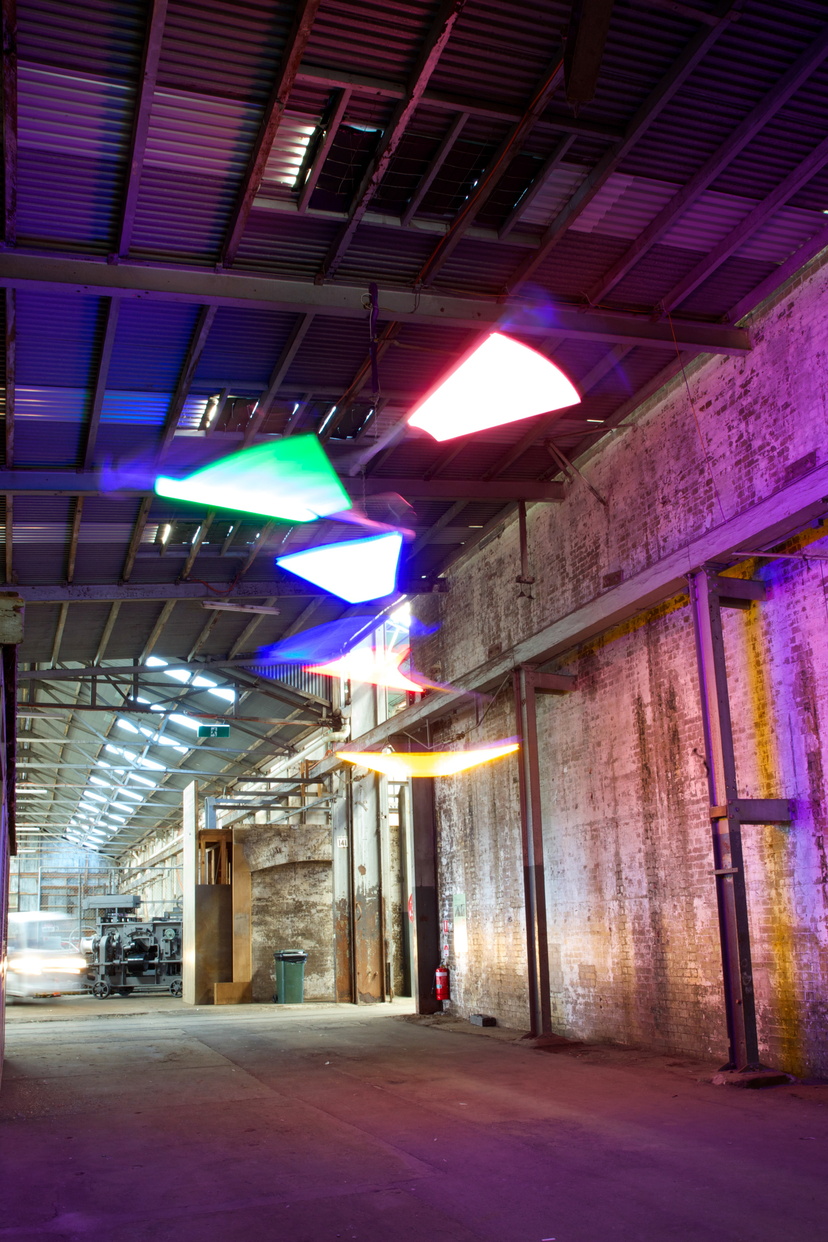
Ross Manning, Spectra VI (2014). Installation view of the 19th Biennale of Sydney at Cockatoo Island.
Courtesy the artist; Milani Gallery, Brisbane; and Starkwhite, Auckland. Photo: Ben Symons.
In the Art Gallery of NSW, Meriç Algün Ringborg (Turkey) produced what might be called a classic Biennale-style work: The Library of Unborrowed Books, Section III: SMSA Library, Sydney (2014), where viewers could peruse an assortment of books from the Sydney Mechanics’ School of Art Library which had suffered neglect. As the title of the work suggests, this was the third iteration of this work, which had previously derived from Stockholm Public Library and New York’s Centre for Fiction. But as the examples of the first two versions suggest, there is no connection between the libraries, which would have made this project marginally more interesting. Once the first flush of fascination had subsided, one could only be cynically impressed with the ‘have idea, can travel’ structure of the work. From the meretricious to the harrowing, Bindi Cole’s We All Need Forgiveness (2014) was a multi-channelled grid of video monitors enframing faces —crying, grimacing, uncomfortable, and serene—uttering the line, ‘I forgive you’. The people were both Indigenous Australian and not, and had clearly been briefed to imagine something in their own lives they felt strongly about, since very few responses looked inauthentic. Communicative and compelling, this work was deeply moral and political without in any way being didactic since it drew from the immediacy of human experience, where strength and frailty conjoin.
A similar viscerality was afforded by the Biennale’s poster showpiece, Douglas Gordon’s Phantom, an installation with cinders of a grand piano presided over by a sinister blackened eye who is the anonymous, impartial witness to a ballad by Rufus Wainwright about love and loss. This work made one reflect on how many Australian artists have the ability for conveying deep melancholy. Given so much of our culture’s amnesiac buoyancy, the poetic rewards of melancholy are not as deep as in countries where the winters are darker, colder and wetter. Fellow Glaswegian Jim Lambie lifted the tone with his iridescent floor installation with the funky title Zobop (2014) made of vinyl tape based on the physical contours of the rooms. As an architecturally based work it was not only optically but physically striking, as the viewer was made self-conscious of his/her own movements while walking through the empty museum space.
Of the works at Artspace, perhaps the most resonant were the photographs by the Chinese artist Taca Sui, The Book of Odes (2011), a series of black and white silver gelatin prints based on an ancient text of transcribed oral poems from rural China. The photographs were not of the frenetic modernising behemoth of China, but of the countryside. In the abstraction that black and white can bring, these works had a silent, wistful quality that was suffused with innumerable forgotten and untold stories from remote areas. The crisp bareness of these works exude an almost forensic detachment, as if the artist and his subject are permanently riven. His was a glimpse of what this Biennale could have been: it could have sacrificed the crazy and up-beat for a little more danger and reflection.